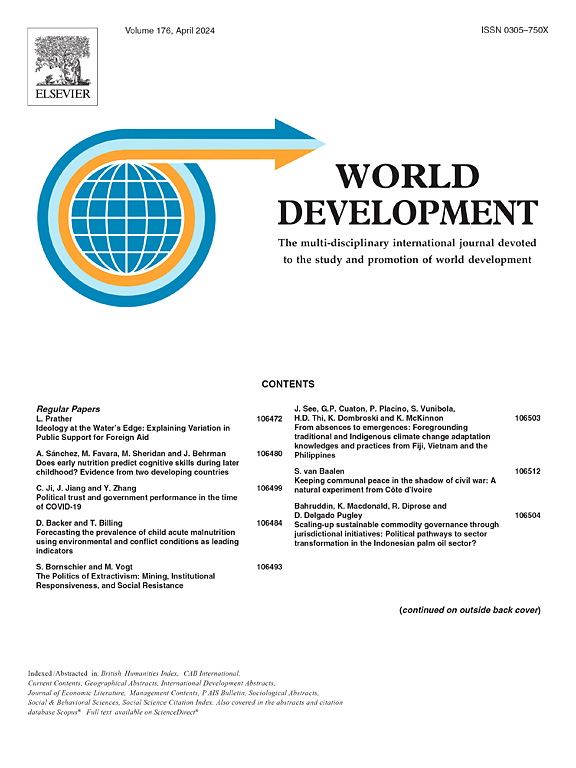“Mitti se Sona [Gold from Dirt]?”: Solar India and colonial modernity in Agropastoral Rajasthan
IF 5.4
1区 经济学
Q1 DEVELOPMENT STUDIES
引用次数: 0
Abstract
Reflecting the prioritization of techno “fixes” over the socio-political dimension leading to anthropogenic climate change, there is a global surge of interest and investments in lower-carbon energy projects. India seeks to project itself as an energy transitions frontrunner, touting the world’s fourth-largest installed capacity of lower-carbon energy. Central to India’s aspirations is a 500 GW target of installed non-fossil energy capacity by 2030, accounting for half its electricity generation. This ambitious goal contrasts starkly with negligible solar capacity at the 2010 launch of the National Solar Mission, underscoring the monumental shift powered by solar photovoltaics. Alongside the impressive strides of Solar India, in part deployed for ostensible sustainability transitions efforts, the imaginaries and praxes of energy futures have caused socio-ecological harms in the present, particularly concerning land access and resource control in fragile desert geographies. Drawing from rich traditions of political ecology, energy geographies, and agrarian studies, our research unravels nuanced facets of India’s energy transition, focusing on Rajasthan state as a pivotal case study based on ethnographic fieldwork. We argue that while the bleak implications of Solar India for rural agropastoral communities are not inherent to energy transitions as such, they are deeply entrenched within its current regime and manifest through colonial modernity, an imposed project of assimilating indigenous and agropastoral peoples towards industrial lifeways.
“Mitti se Sona(泥土中的金子)?”:拉贾斯坦邦农业牧区的太阳能印度和殖民现代性
全球对低碳能源项目的兴趣和投资激增,反映了技术“修复”优先于导致人为气候变化的社会政治层面。印度试图把自己打造成能源转型的领跑者,吹嘘自己拥有世界第四大低碳能源装机容量。印度实现这一目标的核心是到2030年非化石能源装机容量达到5亿瓦,占其发电量的一半。这一雄心勃勃的目标与2010年国家太阳能计划启动时微不足道的太阳能容量形成鲜明对比,突显了太阳能光伏发电的巨大转变。除了印度太阳能公司令人印象深刻的进步,部分是为了表面上的可持续性转型努力,能源未来的想象和实践在目前造成了社会生态危害,特别是在脆弱的沙漠地区的土地获取和资源控制方面。借鉴政治生态学、能源地理学和农业研究的丰富传统,我们的研究揭示了印度能源转型的微妙方面,重点关注拉贾斯坦邦作为基于民族志田野调查的关键案例研究。我们认为,虽然太阳能印度对农村农牧社区的惨淡影响并不是能源转型所固有的,但它们在当前制度中根深蒂固,并通过殖民现代性表现出来,这是一个将土著和农牧民族同化为工业生活方式的强加项目。
本文章由计算机程序翻译,如有差异,请以英文原文为准。
求助全文
约1分钟内获得全文
求助全文
来源期刊

World Development
Multiple-
CiteScore
12.70
自引率
5.80%
发文量
320
期刊介绍:
World Development is a multi-disciplinary monthly journal of development studies. It seeks to explore ways of improving standards of living, and the human condition generally, by examining potential solutions to problems such as: poverty, unemployment, malnutrition, disease, lack of shelter, environmental degradation, inadequate scientific and technological resources, trade and payments imbalances, international debt, gender and ethnic discrimination, militarism and civil conflict, and lack of popular participation in economic and political life. Contributions offer constructive ideas and analysis, and highlight the lessons to be learned from the experiences of different nations, societies, and economies.
 求助内容:
求助内容: 应助结果提醒方式:
应助结果提醒方式:


